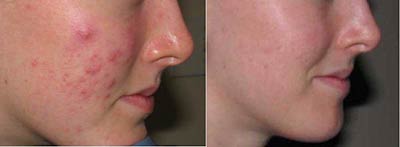Acne
Approximately 40-50 million Americans have acne. Acne can occur at any age. It commonly affects teens (up to 85% of U.S. teenagers), but it also commonly affects young and middle-age adults, in particular, premenopausal women. Although its exact cause is unknown, acne is associated with excess oil, clogged pores, surface bacteria and inflammation. It commonly appears on the face and shoulders but also occur on the trunk, arms, legs and buttocks. Normally, the oil glands help keep the skin lubricated but when these glands are overactive, the pores on the skin can become blocked. This blockage may produce a comedome, a small bump with a top that may be white or black. If it ruptures, the material inside, including oil and bacteria, can spread to the surrounding area and cause an inflammatory reaction. This usually results in an inflamed lesion such as papule (pimple), pustule (pus-filled pimple), or a larger, painful nodule or cyst. Factors that make acne worse include: genetics, menstruation, hormones and emotional stress.
Treatment
Since acne has many forms, Dr. Hearth can design an individual approach to successfully control your breakouts. Any acne treatment takes time, approximately 4-8 weeks to see significant improvement. Continuing treatment is usually necessary to maintain improvement.

Conventional therapy usually includes treatment with topical medications (applied to skin), or a combination of topical and systemic (oral) medications. Oral medications may include antibiotics for moderate to severe acne. Also, certain medications that decrease the effects of male hormones on the skin/oil glands may be helpful for certain women. Isotretinoin (Accutane) is another systemic treatment that may be used for severe, resistant or nodular/cystic acne.
More recent advances have allowed us to successfully treat acne with laser and lightbased technologies. These treatments are often helpful for mild to moderate acne. It may be an option for those not responding to conventional treatment and for those who would like to avoid oral medications. These treatments include treatment with Blu-U light and PDT (photodynamic therapy). Blue-U light is a unique therapeutic light treatment that treats inflammatory acne by destroying the most common type of bacteria that causes acne. Photodynamic therapy is an acne treatment that utilizes the topical application of a medication (Levulan®) to the skin prior to treatment with a laser or light. The laser or light activates the medication which can destroy the bacteria that cause acne, as well as decrease oil production in the skin.
Microdermabrasion and/or superficial chemical peels often boost one's response to treatments. Acne extractions may also be necessary for optimal improvement. Small injections of cortisone into larger pimples or cysts are often desirable to quickly reduce/resolve stubborn lesions. These treatments are often covered by most insurance plans.

